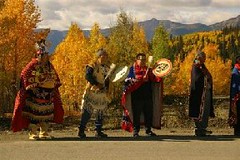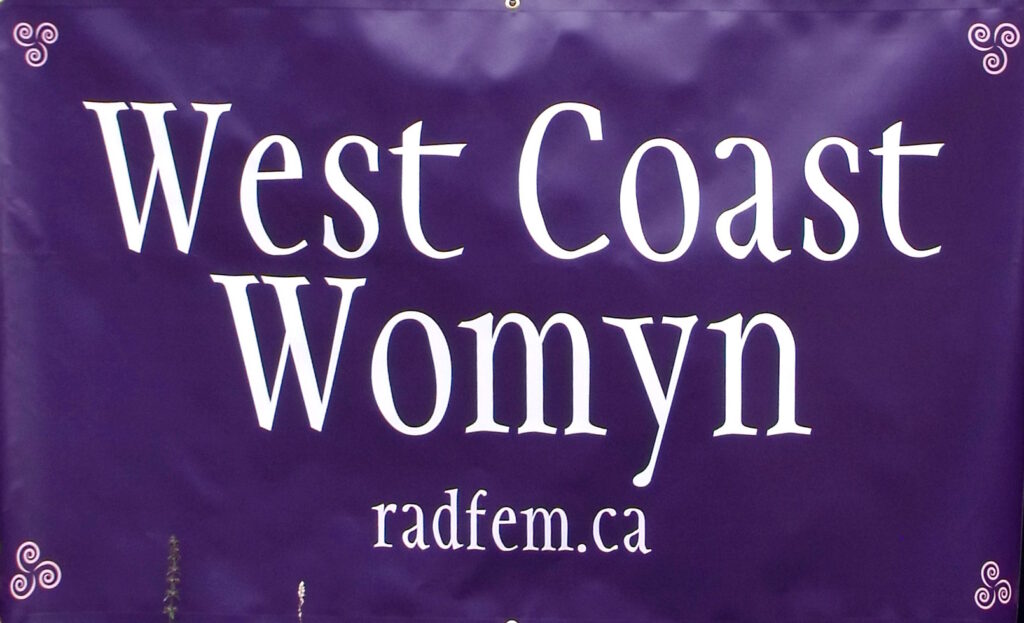
September 2005: Representatives from the Wet’suweetin and Gitxsan First Nations drum in support of the Tahltan Elders who went to jail in order to protest the Sacred Headwaters. (Photo by James Dennis 3rd)
Today brings the latest installment in the long-running battle between the Tahltan Nation of Northern British Columbia and mining corporations intent on the large-scale, toxic extraction of gold and copper in their traditional territory. What’s at stake here includes the traditional hunting and fishing grounds on which these indigenous people still rely to feed their families.
Despite a court injunction against the natives, the road blockade was on again this week, and police arrested great-grandmother Lillian Moyer of the Iskut Band of the Tahltan Nation for blocking the road and refusing to allow the mining equipment to enter in defiance of the court order
Today’s reports come to us from the Iskut Band press release, the Vancouver Province, and the Seattle Post-Intelligencer. The last piece, by Joel Connelly, includes some sharp and refreshing analysis of the scorched earth politics of BC’s mining industry.
News Release: Grandmother arrested at Iskut blockade
Monday September 11, 2006 12:40 PM
Iskut, B.C. (September 10, 2006) Lillian Moyer, a 67-year-old grandmother, was arrested yesterday at a First Nations road blockade near the Village of Iskut in northern B.C. For two months, the blockade has been preventing Vancouver mining company bcMetals from conducting exploration for a copper-gold mine in the Todagin Plateau area south of Dease Lake.
Community members allege that following the arrest, bcMetals heavy equipment leaked oil into trout-bearing Coyote Creek. They intend to hold the company accountable for the spill under Canadas Fisheries Act.
“Todays oil spill is our worst nightmare coming true,” said Rhoda Quock, a spokesperson with the Iskut elders group Klabona Keepers. “It shows what happens to our lands when development is rammed through without proper
consultation.”
Lillian Moyer, who lives in Telegraph Creek, chose to be arrested on behalf of the Iskut people after RCMP informed blockaders that if arrested, they would be denied access to their fall hunting grounds.
“I am being arrested today for the people of Iskut, for the people of Telegraph Creek, and especially for our grandchildren,” Moyer told supporters. This is from my heart. I believe my ancestors are speaking through me.”
Over 100 people were present at the blockade, including hereditary leaders of the Gitxsan and Wetsuweten First Nations who traveled to Iskut to show their support.
“We are here to support the Tahltan because the rivers that flow from here connect our people, and what happens in these headwaters affect everyone,” said hereditary Wetsuweten leader Alphonse Gagnon.
The Todagin Plateau is a traditional-use area of the Iskut people and home to one of the worlds largest populations of stone sheep. Last fall, nine elders and six others were arrested at the same location for blocking Fortune Minerals access to the Sacred Headwaters the shared birthplace of the Skeena, Nass and Stikine-Iskut Rivers.*
New northern mine worries native
Great-grandmother arrested for joining blockade to stop ‘threat’
Ethan Baron
The Province
Monday, September 11, 2006
A native great-grandmother has been arrested in a bid to stop B.C.‘s first new metal mine in 10 years.
BCMetals Corp. believes the Red Chris mine in northern B.C. contains almost a million tonnes of copper and 1.2 million ounces of gold.
But Tahltan elder Lillian Moyer, 67, who was arrested Saturday, says the proposed open-pit operation south of Dease Lake would violate sacred ground, threaten traditional hunting land and ruin fisheries.
“The land means so much to our people,” Moyer said yesterday. “We don’t want to see any development up there because it is sacred land. I am doing what I can, with great feelings in my heart, to stick up for our rights and for the land, for the future generations of young children.”
Members of the Tahltan set up a road blockade June 16 to keep BCMetals from driving heavy equipment through a fish-spawning creek. On Sept. 1, the company’s application in B.C. Supreme Court for an injunction to remove the protesters was granted.
Moyer said she visited the blockade Friday night and learned that anyone arrested for violating the injunction would be prohibited from entering traditional hunting grounds on the Todagin Plateau, the site of the planned mine.
“I was listening to all this and I said, ‘This doesn’t sound right. Why are we being threatened about our own traditional land that we want to protect?’”
Natives spend a month a year camped on the plateau, hunting, Moyer said.
BCMetals president and CEO Ian Smith has said that “the Red Chris mine has received all necessary environmental approvals from federal and provincial authorities.”
On July 4, the company said it had temporarily suspended movement of equipment to explore the Red Chris site because trout were spawning at a creek crossing on the access road.
On Saturday, when equipment crossed the creek after RCMP arrested Moyer, oil spilled into the creek.
“[This] oil spill is our worst nightmare coming true,” said Rhoda Quock, chief of the Iskut band, part of the Tahltan Nation. “It shows what happens to our lands when development is rammed through.”
BCMetals said the spill amounted to less than a half-litre of grease and other hydrocarbons, which washed off the drilling rig and escaped catchment booms.
The Iskut also worry that toxic copper dust will blow from the mine to their community 18 kilometres away, and that leachate from waste ore will contaminate drinking water and fish-bearing streams.
BCMetals expects the mine will produce 50,000 tonnes of copper and 75,000 ounces of gold annually for the first five years. At current prices, that’s $440 million in copper and $51 million in gold.
ebaron@png.canwest.com
© The Vancouver Province 2006
Native hunters up north take aim at corporate greed
Friday, August 11, 2006
By JOEL CONNELLY
ISKUT, B.C. — Like their boomer counterparts across the border in Alaska, British Columbia’s politicians dream big dreams of industrial development, but end up spending taxpayers’ dollars on bridges to nowhere.
A $3 million bridge across the Stikine River was built in the late 1970s for B.C. Rail, even though track laying stopped more than 80 miles away.
Simultaneously, another government agency — B.C. Hydro — was planning a dam that would have put the bridge 300 feet under water.
The severity of the land has turned back the boosters, leaving this wild, gorgeous country with a non-intrusive economy — wilderness tourism and natives’ subsistence hunting and fishing.
“The story of the Stikine has essentially been one of false hopes and would-be developments … of railway lines not quite constructed; grand telegraph proposals that failed … gold mines that petered out; copper and coal deposits that defied development, and on and on,” Alaska Geographic magazine observed in the early 1980s.
Twenty-five years later, gold and copper prices are up and a global economy demands “resources” to keep expanding.
But native peoples, who inhabit the 20,000-square-mile Stikine drainage, worry that sacred places will be used and abused, and that multinational companies will “extract” wealth and then walk away.
“The health of the people and health of the land are directly connected. … Everything that we eat comes from here,” said Gerald Amos, chairman of the Nanakila Institute in Kitimat.
Marie Louie, leader of the Iskut Band, notes that several great rivers rise in close proximity among nearby mountains and meadow-covered plateaus.
“If pollution from development goes into one river, it goes into all of the rivers,” Louie said.
On the American side of the border, do we have a dog in this fight?
Yes! Three B.C. river systems where major mining development is proposed — the Stikine, Taku, and Unuk — cross the border into Alaska. All have major salmon runs.
Can subsistence hunters bring down a charging multinational company? Or form a united front against corporate tactics of divide and conquer?
It does happen. In the 1950s, Dr. Edward Teller (“Father of the H-Bomb”) championed a scheme to use nuclear weapons to carve out a harbor in Arctic Alaska. Successful resistance to “Project Chariot” united native villages.
In British Columbia, native leaders in ceremonial robes blocked logging trucks on Lyell Island in the Queen Charlottes. The protest helped create Canada’s Gwaii Haanas National Park Reserve.
Haida natives later went to court and won a greater voice in how Weyerhaeuser logs its lands.
The great MacKenzie Valley of the Northwest Territories was slated for a natural-gas pipeline in the 1970s. Native villages took their case to a government inquiry headed by B.C. Supreme Court Justice Thomas Berger.
Berger’s scathing report blocked the pipeline. The project is likely to go ahead, three decades later, with far more direct involvement by the valley’s aboriginal residents.
Yet, the airplane flight back down to Vancouver shows the pains of a resource economy.
At sunset, you can look down and see thousands of drowned trees sticking out of the Ootsa Lake reservoir. Ootsa is a natural lake, dammed and vastly enlarged in the 1950s. Its waters were redirected through the Coast Range to power the giant aluminum smelter at Kitimat.
The lands to be flooded were not logged. Thousands of moose, elk and woodland caribou drowned in the debris-filled reservoir. Native subsistence hunters were packed off to farms bought by the government. The result: rampant alcoholism.
At Brittania Beach, en route from Vancouver to Whistler, is a mine that once produced more copper ore than any other site in the British commonwealth.
Anaconda pulled out in November 1974, making no effort to clean up the mine and its chemical wastes.
It left behind the largest source of metal pollution in North America. A $30 million water treatment plant opened in April of this year, more than 35 years after closure of the mine.
It has made strides in environmental management, but the mining industry remains a bossy, reactionary force in British Columbia. Mining is the province’s third-ranking industry, behind forestry and tourism.
It throws its weight around. A pro-business government under Premier Gordon Campbell took office in 2001. The mining lobby began a drive to reduce by more than 90 percent the popular, newly created South Chilcotin Provincial Park, north of Whistler.
The miners backed off only when warned that environmental protests would torpedo Vancouver’s bid for the 2010 Winter Olympics.
Vancouver newspapers love to depict B.C. environmentalists as strident and unreasonable, while putting industry’s plans in the friendliest focus.
With natives, however, the sneering stops.
They’ve been here 300 years, living off a land that has defeated boomers’ big dreams. They stand their ground, once even driving off Greenpeace anti-hunting activists who flew up from Vancouver.
Used to pushing people and governments around, mining companies may be compelled to walk humbly on the land. It’ll be a character-building lesson.
P-I columnist Joel Connelly can be reached at 206-448-8160 or joelconnelly@seattlepi.com.

